3D Printed Curta Part VIII
- Marcus Wu
- 3 dprinting , Curta
- April 28, 2016
Transmission shafts
As an Amazon Associate I earn from qualifying purchases.
Printing
I printed the transmission shafts in groups. There were three different shafts some with with grooves at different heights along the shafts, but most had no grooves. The grooves allow for clips to keep a gear or rotation lockout at a certain height.
I printed all shafts at 80% infill. I also printed them combined with their crown gear tops which added supports, but eliminated the need for a tool to help me offset the crown gears properly. If I were to do it again I would try printing them separately, but it might be better the way I did it. The crown gear tops were kind of fragile – I had to reprint a few transmission shafts due to breaking them off.
Fitting
The transmission shafts needed some sanding to smooth them out. The holes in the upper main casting and the bearing plate also needed their holes widened for a sliding fit to allow for easy rotation. To widen the holes I used a set of needle files I got at my local hardware store. The Amazon link is to the set I found. There are cheaper sets on Amazon, but I like this set since the files can be used without the handle which helps for tight spots.
You might notice in the top-down picture in the next section below that some of the shafts look different from the top than others. When I initially scaled the parts up, the offset of the shaft into the crown gear top did not get scaled alongside the parts so the shafts were not inserted into the crown gears as far as they should have been. That wasn’t a problem except that the shafts were now too long. Since FDM printed parts are weakest along the joint between two layers, I was able to measure out the extra length, then mark and snap off the extra smoothly at the without having to reprint them.
Count gears, lock gears, and sleeves
Once the transmission shafts were printed and in place, I printed the gears needed for the transmission shafts. They are supposed to be press fit together on sleeves that slide fit onto the transmission shafts.
Press fitting might be necessary for machining, but I printed them as one piece to avoid press fitting small pieces that would likely break in the process. That did mean support material, but it turned out well on these small pieces to use Simplify3D’s supports without a higher density interface layer.
The first group of gears I printed came out nicely, but I had to do a lot of work to fit them onto the transmission shafts. To reduce that, I modified the sleeves to widen them a small amount. It was easy to do them all at once in OnShape because I based them all on one sketch.
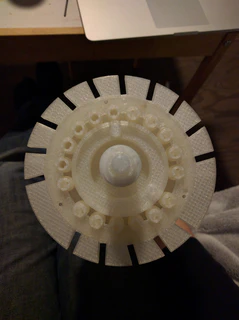
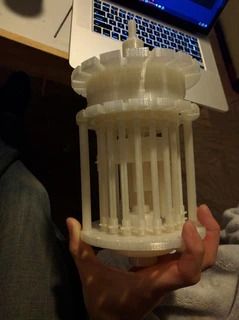
Lubricating
Once I had the transmission shafts gears assembled into the frame, I manually positioned the gears and test ran the Curta. It worked well, but plastic on plastic was squeaking.
To resolve this, I used a spray-on dry PTFE lubricant . I disassembled the entire Curta and lubricated each part that spins or slides against another. I didn’t lubricate everything because certain parts of a Curta should not be lubricated. The results were incredible. It eliminated the squeak and an amount of friction I didn’t know was possible to remove.
Tens levers
Printing
The tens levers were a trick to print. They are normally formed from sheets of metal that are cut and then bent.
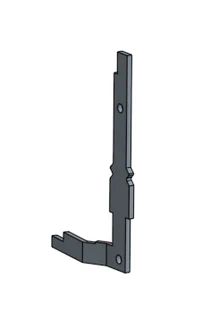
I tried printing these lying flat, but the bends cause weak sections where the layers have a small cross-section of adherence.
I ended up printing them upright which came with its own challenges. Upright they have a small footprint so keeping then stuck to the bed was an issue. I first tried lining them up along the x axis to reduce y axis movement and vibration. That did not work – they still fell over. My next attempt worked. I turned them aligning them along the y axis which gave them batter adhesion along the moving axis.
I also printed the carry lever bearing blocks they require a small amount of supports. There may be a way to re-engineer them to eliminate the need, but it was easy enough to print and remove the supports. Simplify3D showed it’s value here and throughout the project.
Fitting
The carry levers did require some filing to fit their bearings, but that isn’t too surprising given the narrow parts. The amount was minimal and I got pretty quick at it once I knew which areas needed work to get smooth movement.
In addition to needing to fit the levers into the bearings, the bearings needed fitting into the upper main casting and custom springs needed to be made to support the proper motion.
Carry Lever Springs
The springs have their own engineering drawing depicted below. In order to get an accurate shape consistently, I decided to design and print a jig to make the springs. I used a music wire near 0.6mm in diameter I found at a local hardware store. The jig is simply a block with a few holes in it with a diameter near that of the music wire. The holes are of the lengths necessary to make bends at the desired offsets. Music wire will spring back from the bend some so I used a pair of needle nose pliers to finish off the springs.
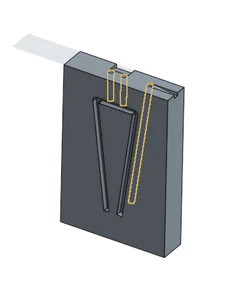
Adjusting; Eliminating bend
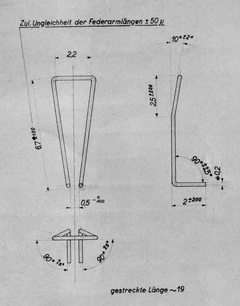
The first spring I made was scaled directly from the engineering drawing. It was a little bit too long to properly snap the tens carry lever into position.
I altered and reprinted my jig for the springs and had a better length, but I had problems with the legs of the spring catching on the shoulders of the tens carry bearing. That problem was solved by eliminating the 10° bend at the opposite end of the spring from the legs. I guess scale changed the requirements of the spring.
Calibration
Once I could crank out springs that would consistently work for the carry levers, I had to actually calibrate each carry lever. The tens bell has a ramped section which resets the carry levers from their lowered carry position to their raised no carry position. The springs help keep the levers from being between the upper and lower positions, but each lever will have slightly different friction and each spring will have slightly different pressure. This means that the amount the tens bell has to press upwards on a carry lever to get it to reset may vary a little bit per carry lever.
In order account for that variation, the carry lever bearings allow a range of height positioning in the upper main casting. Each carry lever is adjusted height-wise until it can easily be triggered then reset by the tens bell and the lower position aligns the carry gear with the tooth on the tens bell.
This step took some time and patience. I had to adjust everything multiple times to get them right. Once each carry lever was working properly, I tightened down the screw next to it to prevent it from shifting.
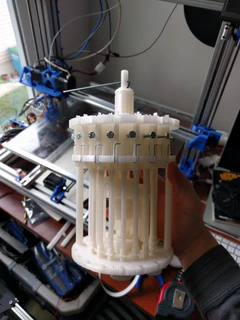
Selector shaft assemblies
Printing – knobs, shafts, guide screws, bearing pins, and plates
The selector shafts are comprised of multiple printed pieces. There is the shaft itself, the knob, a guide screw which facilitates the shaft’s rotation, a bearing pin, and a couple of plates which hold a set of four shafts on the Curta.
I printed the shafts in two parts in order to reduce the support needed and to avoid having to force fit the number roll onto the shaft. I added a key to the two parts in a way similar to how I did on the main shaft in order to make sure they mate properly. I printed both at 100% infill. I also added a raft to prevent them from falling over during the print.
I considered printing the selector knobs and guide screws together as one piece, but decided to try printing as separate pieces and cutting thread into them. I printed the selector knobs at 30% infill and the guide screws at 100% infill. I also printed the ones, thousands, and millions digit selector shafts in red. The rest were printed in black.
I printed the bearing pins at 100% infill for strength (the pin tips are narrow and must keep the selector shafts in place) and the bearing plates at 30%. There wasn’t anything special with these pieces – they printed well with no special settings needed aside from infill settings.
Threading
Each selector knob needed thread to accept the guide screws. Each plate also receives two M4 screws to hold it in place. The bearing plate needed threading there to accept the M4 screws. The holes were easily threaded. The guide screws were more difficult. I sheared two off inside the die before I figured out I was using too much pressure and moving too quickly. It also helped to turn the die backwards more frequently to clear out the shavings which helped eliminate unnecessary force.
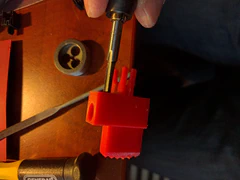
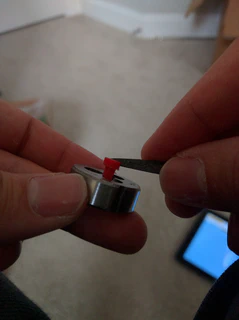
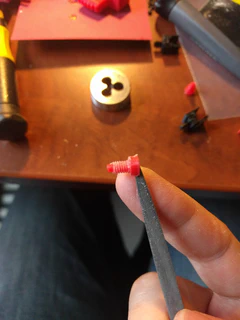
Engineering drawing error
After completing my first selector shaft print and adding it to my Curta, I realized that it did not align the transmission gear to the step drum properly. I looked around the internet at pictures of Curtas and at vcalc.net’s disassembly images and came to the conclusion that at the zero position, my selector knobs were aligning too low by about 1.2mm.
I wasn’t sure at first why the knobs were too low. It could be cummulative error in the sizes of the parts of the curta causing misalignment or a mistake in one of the models I made or even a problem with the engineering drawings (I had already seen one in Part VII with the main shaft alignment).
In order to figure that out, I got measurements made directly off of a real Curta by Cody Brocious who is working on a project to fabricate a 1:1 scale Curta by machining the parts. His measurements showed me that the distance from the top of the selector shaft to the first divot where the selector knob sits was different on an actual Curta from the engineering drawings by ~0.4mm which corresponds to my misalignment of 1.2mm when scaled up to 3:1.
In OnShape, this was an easy fix – I altered a couple of parameters to the model and was able to print copies of the selector shaft with the correct dimensions.
Assembly
I assembled the selector shafts using springs from McMaster Carr and #TT sized steel balls from ballisticproducts.com using the method I described in an earlier post . One notable difference is that I added the use of the PTFE lubricant.
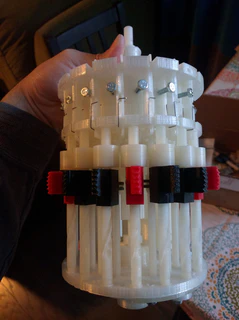
Reversing lever
Threading
I threaded the top of the reversing lever shaft in much the same way as I did the selector knob guide screws. I had more trouble keeping the shaft normal to the die than I did the guide screws. I was concerned that this might cause the threads to be torn off as the shaft turned deeper into the die, but that fate was avoided. The M4 nut that holds the reversing lever on doesn’t sit perfectly flat, but it seems to do the job.
Assembly
Assembling the reversing lever and shaft went smoothly after having done the same for all of the selector shafts. I used a narrow hex wrench to press the ball bearing and spring into the reversing lever knob and then just slid the shaft on to the point where the edge of it covered enough of the bearing to hold it in place. I then removed the hex wrench and slid the shaft the rest of the way through. On the reversing lever there is no guide slot or guide screw so a little bit of toying with it was necessary to find the right spot for the ball bearing to engage one of the two divots on the reversing lever shaft.
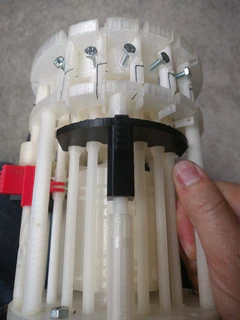
Breaking the Curta’s main shaft
The reversing lever’s knob engages all of the turns counter gears. The gears need to spin freely in the portion of the reversing lever that holds them in place. I did not check that thoroughly enough and combined with other gears getting caught up in the device, I managed to break the main shaft. The shaft broke right at the hole for the pin that connect the crank handle. It broke there because that is where I was applying pressure to turn the main shaft (I was using a small hex wrench to turn it).
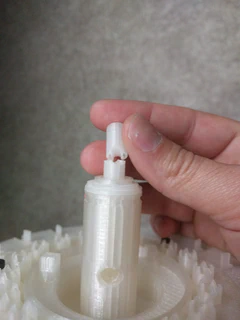
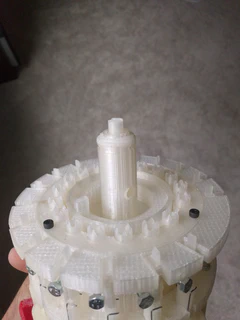
The main shaft was printed as one piece combined with the step drum and all its toothed segments in a twelve hour print. I have already reprinted the entire thing, but disassembly and reassembly of everything I have done so far is still in my future. While I am in there, I will be adding the parts of the Curta back one at a time and checking friction at every step of the way, filing and re-lubricating any part that shows trouble.
The device should run smoothly and it wasn’t doing that when it broke. In fact, there were a several times the Curta got hung up and I couldn’t immediately see why it was seizing. It ran pretty smoothly before I added the digit selectors and reversing lever, so I am pretty sure the problem is that the gears don’t spin freely when mated with their respective knobs. In some cases I was lazy and pushed harder instead of doing what I should have which is to find what was catching and fix it. This caused stress where the hex wrench pressed against the edge of the hole it went through that weakened and eventually broke the main axle at that point.
I decided to improve the strength of the main axle while I was reprinting it. Instead of the 30% infill I printed it at originally, I was able to tell Simplify3D to print the main shaft portion of the model containing both the step drum and the main shaft at 100% infill. I shouldn’t need the added strength once I fix the issues as I reassemble it, but it will be nice to have that piece of mind.